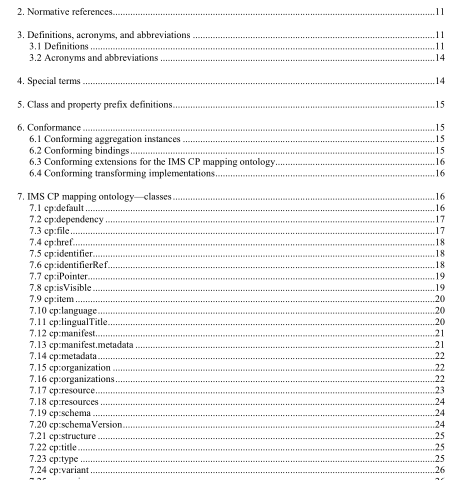IEEE 1484.13.4-2016 pdf download.IEEE Recommended Practice for Learning Technology—IMS Content Packaging Information Model (CP) Version 1 .2—Mapping to the Conceptual Model for Resource Aggregation
3. Definitions, acronyms, and abbreviations
3.1 Definitions
For the purposes of this document, the following terms and definitions apply. The IEEE Standards Dictionary Online should be consulted for terms not defined in this clause.
4 Most definitions are borrowed from IEEE Std 1484.13.1-2012. aggregation definition document: A document that lists and structures the digital resources of an aggregation.
5 See also: aggregation format; aggregation instance; digital resource; resource aggregation. aggregation format: A documented method of aggregating digital resources into a complex object that can be exchanged among systems. An aggregation format may be defined by a formal specification or standard, but may also be informal.
The defining characteristic is that an aggregation format specifies how to combine digital resources into a structured whole, without prescribing the kinds of digital resources, their internal structures, or their intended
uses. See also: aggregation instance; digital resource; mapping.
aggregation instance: An instantiation of an aggregation definition document that includes all data necessary to construct a complex object including any references to external data. Multiple aggregation instances, each of which conforms to a different aggregation format, may exist for the same complex object.
See also: aggregation definition document; aggregation format.
binding: The process that binds a model to a data structure. For example, it can refer to the binding of a conceptual model to the Web Ontology Language (OWL).
6 class: A category of items that share one or more common characteristics. Characteristics can be described informally in a scope note or formally as properties explicitly formulated in logical terms.
A class cannot be defined by enumerating its instances because it is generally impossible to know all instances of a class in the world, and the future can bring new instances into being at any time.
See also: class instance; inheritance; scope note.
class instance: An instantiation of a class. A class instance has properties that meet the criteria of the intention of the class. The number of instances of a given class declared in an information system is usually less than the total number of instances in the real world. For example, although an individual is an instance of “person,” the individual may not be mentioned in all information systems describing “persons.” See also: class; intention; property. component: Any data attribute or data element as described by the data model of an aggregation format. See also: data attribute; data element; aggregation format.
data attribute: A characteristic of a unit of data, often expressed in Extensible Markup Language (XML).
data element: A uniquely named and defined component of the data model of an aggregation format into which data items (actual values) can be placed. See also: aggregation format; component. digital resource: Any resource that can be expressed in an electronic format, such as binary formats, Extensible Markup Language (XML), plain text, various encodings (e.g., base64), media-specific formats, and compressed archives (e.g., zip files). See also: aggregation definition document; aggregation format.
NOTE—Media-specific formats include Joint Photographic Experts Group (JPEG) 7 and MPEG-1 Audio Layer 3 (MP3). 8 domain: A constraint on a property that limits the class instances to which the property can be applied. Instances of a property are applicable to instances of its domain. For example, if property A has only the classes X and Y as a domain, then only instances of classes X and Y can have property A. See also: class; class instance; property; property instance;
range. identifier: Associates a name with a thing. Context defines how the name is interpreted. Within a given context, a name is unique. inheritance: The ability of classes to derive characteristics from other classes and properties to derive characteristics from other properties. If characteristics are removed from a class or property, they are also removed from its subclasses or subproperties. See also: class; multiple inheritance; property; subclass; subproperty.
intention: The intended meaning of a class or property. The intention consists of the common characteristics shared by all instances of the class or property. The intention need not be explicitly formulated as properties in the case of a class or as the domain and range in the case of a property. Instead, the intention can be described in a scope note that refers to a conceptualization shared by domain experts.
See also: class; class instance; domain; property; property instance; range; scope note. mapping: An ontology of an aggregation format that relates the aggregation format’s classes and properties to the classes and properties of another ontology. See also: aggregation format.
multiple inheritance: The inheritance of characteristics by a class from more than one immediate superclass or by a property from more than one immediate superproperty. If multiple inheritance is used, the resulting class or property hierarchy is a directed graph, not a tree structure. If multiple inheritance in a class or property hierarchy is represented as an indented list, then some classes or properties will inevitably be repeated at different positions in the indented list. For example, “person” could be a member of both the classes “critic” and “author,” and, therefore, would be repeated at different positions in the indented list. This feature distinguishes an ontology from a simple tree structure. See also: class; inheritance; property; superclass; superproperty.IEEE 1484.13.4 pdf download.IEEE 1484.13.4-2016 pdf download
IEEE 1484.13.4-2016 pdf download

Leave a Reply